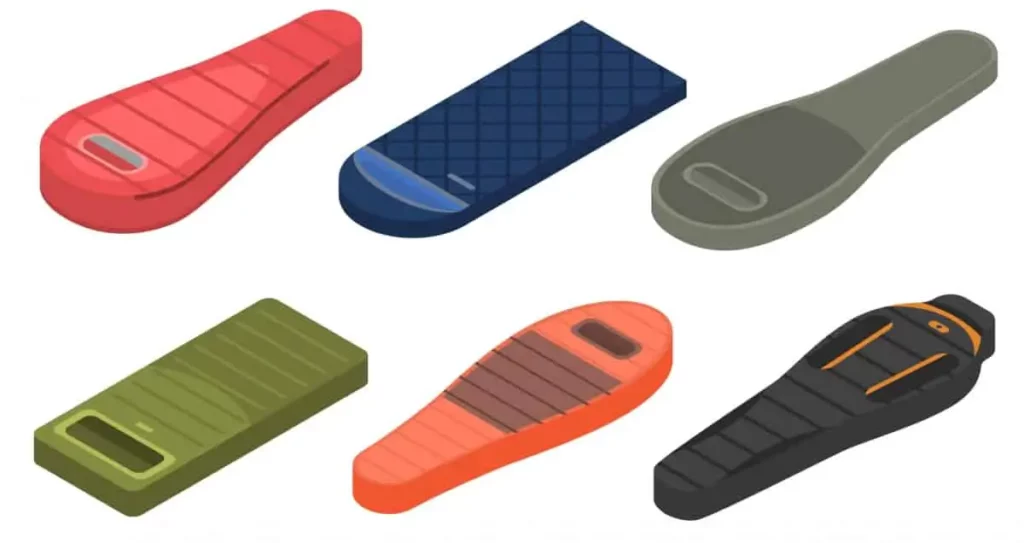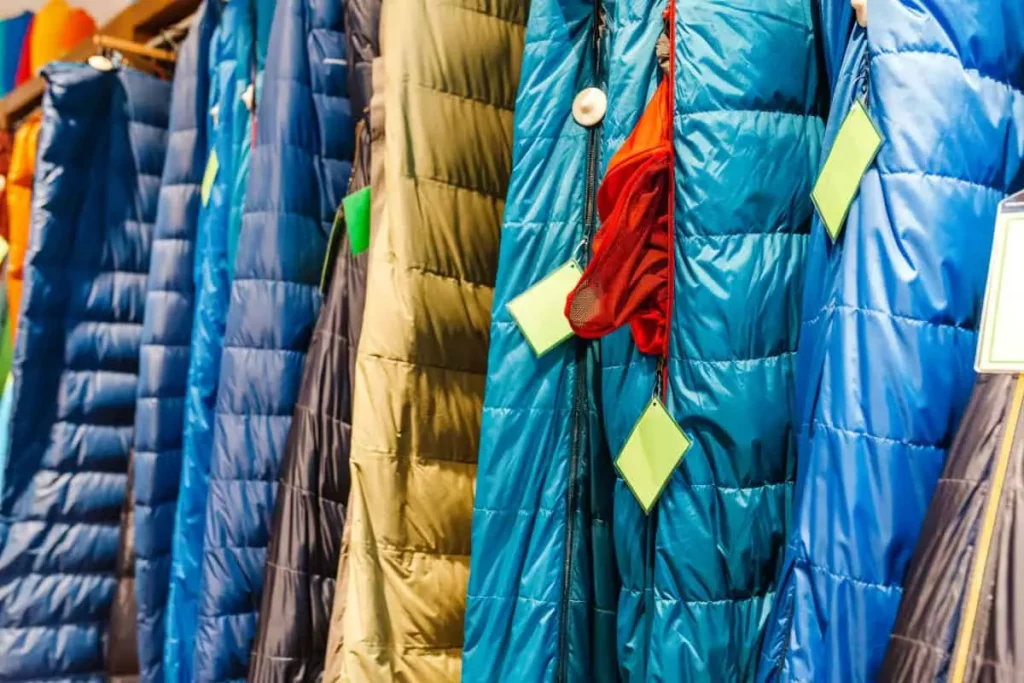This post contains affiliate links.
Your sleeping bag is the difference between a comfortable night of camping and a miserable weekend of sleep deprivation. The money you spend on a high quality sleeping bag will pay you back in warm, restful nights and energy-filled daytime adventures.
The cost of sleeping bags are determined by the type of material used as insulation, the temperature rating to keep you comfortable on cold nights, the size and shape of the bag and the quality of manufacturing that will ensure it survives many adventures to come.
Camping is a fun outdoor activity often involving hiking, swimming and late nights around the campfire. These physical activities require a good night’s rest to make the most of your limited time in the wilderness. Here’s all you need to know to choose the bag that’s right for you.

Table of Contents
Price Range
What if I told you that sleeping bags can cost from $15 to $1,000+? It may sound like a ridiculous range, but there are many things that factor into the price of a sleeping bag and you can be sure that the $15 one looks extremely different from the $1,000 one.
Summer Bags
A main determinant of the price of a sleeping bag is what seasonality it’s rated for. Summer sleeping bags, like the name implies, are rated for the most mild and balmy weather. They don’t need to have any special insulation, they are almost always rectangular in shape, and they are by far the cheapest sleeping bags on the market. They will range in price from $15 to $50.
The exceptions to this are the sleeping bags that are designed to keep you cool in the summer, not just off the ground. These sleeping bags have special materials or ventilation that you’ll end up paying more for.
3 Season Bags
3 season sleeping bags range from $50 to $200, and they are designed to keep you warm in temperatures at and above freezing (32 degrees Fahrenheit). They have more insulation than summer sleeping bags, and the type of insulation is a large determinant of where they fall in the price range.
- 32 Degree Sleeping Bag for Camping: Perfect cold weather sleeping bag features WR 650 fill power duck down insulation with a revolutionary...
- Hiking Gear: Designed for thru-hiking, backpacking and camping, this ultralight sleeping bag boasts superior weight-to-warmth ratio at only...
- Hydrophobic Water Repellent: DWR-Coated camping sleeping bags for adults feature 400T 20 D ripstop nylon fabric liner, 2 large YKK zippers...
4 Season Bags
4 season or winter sleeping bags are more expensive yet. These are almost all mummy-style bags that will keep you warm in temperatures anywhere from 20 degrees down to 0 degrees depending on the bag’s rating. Insulation is still a large factor in price, and you can expect to pay anywhere from $100 to $550 for a true winter bag.
- 0 Degree Sleeping Bag - The Eolus mummy sleeping bag is packed with naturally hydrophobic and warmth-trapping Goose Down equal to 800 Fill...
- Save Space & Shave Weight - This 4 Season winter sleeping bag is professionally designed for thru-hiking, backpacking and camping in...
- Hydrophobic & Water-resistant - The 400T 20D ripstop nylon liner is coated with water repellant DWR, and the superior YKK zippers are also...
Expedition Bags
The last kind of bags, the expeditionary sleeping bags, are designed for subzero temperatures and will keep you warm in the most extreme camping environments. Not many people will find themselves in a situation where they need a sleeping bag like this, but the ones that do will pay top dollar for them – between $100 and $1,000+.
Temperature Rating
The biggest determinant of the price of any sleeping bag is its temperature rating. This rating is how sleeping bags are assigned their seasonality, and like you saw above the colder the weather a sleeping bag is rated for the more expensive it’s likely to be.
EN & ISO Lab Testing
Sleeping bags with an EN (European Norm) or ISO (International Standards Organization) rating have been tested independently at a lab that makes sure one bag’s temperature rating performs the same as another’s.
Comfort Rating
Many bags that are tested by the EN or ISO will come back with two different ratings: the comfort rating and the lower limit rating. The comfort rating is the lowest temperature that someone who is a cool sleeper can expect to stay warm in. Women usually get colder than men when they sleep, so this rating is often used as the main one for womens’ bags.
Lower Limit Rating
On the other hand, the lower limit rating is the lowest temperature that a warmer sleeper can expect to stay warm in. The difference between the comfort rating and lower limit rating is usually 10-20 degrees, and some bags will only have one or the other.
If you have a sleeping bag that has a lower limit rating of 30 degrees, this is going to be a 3 season bag while one with a lower limit rating of -20 degrees would be an expeditionary bag. The temperature rating determines the base price of a sleeping bag, and then the other qualities factor in to give you the final result.
Insulation – Down VS Synthetic
Another main determinant of the price of sleeping bags is the insulation they use. Some 3 season bags and the majority of summer sleeping bags use a synthetic fiber blend for insulation. This material does well in damp conditions, but it isn’t as warm as down feathers.
Down feathers are the soft, fuzzy feathers that birds have close to their bodies to keep them warm. Since down is an animal product it’s automatically more expensive than the synthetic blends, and down is able to keep you warm in much colder temperatures than an equal amount of synthetic insulation.
Fill-Power Rating
The amount of insulation present in a sleeping bag is also a factor in its price. Down is measured in different fill-power ratings on a 0-1000 scale. A sleeping bag with a 700 fill power doesn’t have as much down in it as a sleeping bag with a 900 fill power, and therefore won’t be as warm or as expensive.

Shape of Your Sleeping Bag
While the shape of the sleeping bag isn’t as closely associated with its price as some of the other factors, you can expect to find sleeping bags in three main shapes: rectangle, barrel, and mummy.
Rectangle Bags
Rectangle sleeping bags are generally the cheapest. They allow you plenty of room to roll over and stretch out, but all that space is also your enemy when you’re trying to stay warm. The majority of summer sleeping bags will be this shape, and you can find the occasional 3 season and winter sleeping bags with a rectangular shape as well.
Mummy Bags
Mummy-shaped sleeping bags, on the other hand, are usually the more expensive ones. These are entirely form-fitting, and instead of rolling over inside of the sleeping bag you roll over with it. Most mummy bags will have a built-in hood and they are going to do a much better job of keeping you warm. The majority of expeditionary and winter sleeping bags are this shape, and some 3 season bags are as well.
Barrel Bags
The compromise between those two bag shapes are the barrel sleeping bags. These are roomier than a mummy bag but warmer and lighter than a rectangle one, and they cover a broad range of both temperature ratings and prices.
Size and Weight
Any camping gear that’s marketed as ‘compact’ or ‘lightweight’ is automatically going to be more expensive than other gear. Why? Because when you’re out backpacking every ounce you have to carry counts, and you need your gear to take up as little space as possible.
You could pile a mountain of synthetic insulation on top of yourself and sleep as snug as a bug in freezing temperatures, but your sleeping bag would be ridiculously heavy and bulky. If you have two bags side by side that are the same temperature rating, the higher-priced one will weigh less and will fold up smaller.
Having said that, there’s only so many corners that you can cut in size and weight before you start to lose warmth. The best sleeping bag for your next camping trip conditions may be heavier than you’d like, but at least you’re guaranteed to get a good night’s sleep.

Durability
Another thing that will have an affect on the price is the overall quality. You can get a cheap sleeping bag that will last you for one or two trips before unraveling or ripping, or you can invest in one that will last you years with proper care.
Nylon and Ripstop
Nylon fabric is the least durable, but it’s also the cheapest. You can expect this fabric to be on the outside of that $15 sleeping bag, but I would plan on having to replace it sooner than later. Ripstop fabric on the other hand is very resistant to tears, but isn’t the most insulating material. This would likely be found on summer sleeping bags with a higher price tag.
Specialty Blends
Most other fabrics used on the outside of sleeping bags fall into the category of “technical textiles” – fabric blends that have been manufactured specifically for this purpose. These are usually durable, insulating yet breathable, and water resistant. You can expect to pay more for these materials, scaling up with the temperature rating of the bag.
Stitching and Zippers
Stitching and zipper quality will also play a role in the overall price and durability. When zippers catch on the fabric it wears the fabric down in addition to being a pain to fix. High-quality zippers will come with a guard that prevents that from becoming an issue. You can tell high-quality stitching apart by both its durability and water resistance.
Improving The Comfort of Your Bag
You’re already shelling out the money for a sleeping bag, so the idea of spending more money on upgrades probably doesn’t appeal to you. That’s completely understandable, but there are two other items that you should strongly consider before you set out: a sleeping pad and a sleeping bag liner.
Check out our post on How To Stay Warm In A Tent for more ideas on getting a comfortable night sleep on your next camping trip.
Sleeping Pad
Why do you need a sleeping pad? They provide both comfort and insulation as you’re sleeping. Any extra material between you and the ground is automatically going to be more comfortable to sleep on, but arguably the most important feature is its insulative properties – sleeping pads keep the cold from the ground from seeping into the sleeping bag.
Whenever sleeping bags are tested to determine their temperature rating, they are always used in conjunction with a sleeping pad. If you’re planning to skip the pad, then you’ll probably want to add 10 degrees to your sleeping bag’s temperature rating to be safe
- REJUVENATE YOUR BODY: Powerlix camping pad has revolutionary hexagon design made with body mapping technology. The hexagon air cells...
- LIVE YOUR LIFE TO THE FULLEST: It's time to plan a trip! Our sleeping pads cannot be easier to inflate with our inflation bag. Easily...
- UNIQUE LONGLASTING DURABILITY: It's the mat of all mats! The inflatable sleeping pad is made of durable, outdoor grade materials. It...
Sleeping Bag Liner
The other thing you’ll want to look into getting is a sleeping bag liner. These are thin pieces of material that go between you and the sleeping bag, and have several big advantages from keeping your sleeping bag cleaner to keeping you warmer.
If you’re venturing out into conditions that are near your sleeping bag’s temperature rating, it’s a great idea to bring a sleeping bag liner for a bit of extra warmth in case the temperature dips lower than anticipated.
- GENEROUS SIZE: 41" x 86" (105 x 220cm) including pillow pocket - this liner allows you to stretch out your legs in any sleeping bag or...
- SILKY SOFT AGAINST YOUR SKIN: Made of durable, easy clean machine-washable polyester with a comfortable silk texture that is soft against...
- KEEPS YOU AND YOUR CAMPING BEDDING CLEAN: Increase the longevity of your sleeping bag by protecting it from bacteria, sweat and other...
Closing Thoughts
Sleeping bags can get pricey, and it can be hard to understand what separates the $15 bag from the $200 and $1,000 bags. The temperature rating is one of the biggest determinants of the price, along with the type of insulation, shape and size, and durability.




